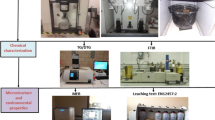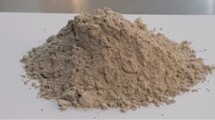Abstract
On the eve of changing laws concerning dredging practices, the recovery of sediments is necessary to create a viable economy for their management. With the evolution of the global environmental context which invites companies to reduce their impact by reusing local materials, dredged sediments represent a potential source of material. Thus, the objective of this study is to develop an ecological concrete via the use of geopolymers that can be poured on site for public works close to the Ports. Recent studies showed that the development of a geopolymer phase when mixing sediments with an alkali reagent is viable due to their mineralogical and chemical composition. However, due to the use of sediments in their natural state, high setting times and shrinkage were observed which could prevent their valorisation. Therefore, this study aims to improve the developed mortars through the co-valorisation of marine sediments with Supplementary Cementitious Materials (SCMs) such as metakaolin and ground granulated blast furnace slag. The sediment-based geopolymer mortars has been analysed through macroscopic and mineralogical tests. The durability has been also studied in order to validate the viable use of sediment based geopolymer mortars. The results showed that the use of metakaolin could be beneficial to improve the compressive strength and durability of the mortars compared to ground granulated blast furnace slag where calcium could be detrimental to the reactions kinetics.
Access this chapter
Tax calculation will be finalised at checkout
Purchases are for personal use only
Similar content being viewed by others
References
Davidovits, J.: Geopolymers: inorganic polymeric new materials. J Therm Anal 37, 1633–1656 (1991)
Van Deventer, J.S.J., Provis, J.L., Duxson, P., Brice, D.G.: Chemical research and climate change as drivers in the commercial adoption of alkali activated materials. Waste Biomass Valor 1, 145–155 (2010)
Duxson, P., Provis, J.L., Lukey, G.C., van Deventer, J.S.J.: The role of inorganic polymer technology in development of “green concrete.” Cem Concr Res 37, 1590–1597 (2007)
Singh, N.B., Middendorf, B.: Geopolymers as an alternative to Portland cement: an overview. Constr. Build. Mater. 237, 117455 (2020)
McLellan, B.C., Williams, R.P., Lay, J., van Riessen, A., Corder, G.D.: Costs and carbon emissions for geopolymer pastes in comparison to ordinary portland cement. J. Clean. Prod. 19(9–10), 1080–1090 (2011)
Karam, R.: Valorisation of non-calcined marine sediments in an alkali-activated binder based on blast furnace slag, Ecole centrale de Nantes (2019)
Ferone, C., et al.: Thermally treated clay sediments as geopolymer source material. Appl. Clay Sci. 107, 195–204 (2015)
Hosseini, S., Brake, N.A., Nikookar, M., Günaydın-Şen, Ö., Snyder, H.A.: Enhanced strength and microstructure of dredged clay sediment-fly ash geopolymer by mechanochemical activation. Constr. Build. Mater. 301, 123984 (2021)
Marsh, A., Heath, A., Patureau, P., Evernden, M., Walker, P.: Phase formation behaviour in alkali activation of clay mixtures. Appl. Clay Sci. 10–21, 175 (2019)
Provis, J.L.: Geopolymers and other alkali activated materials: why, how, and what? Mater. Struct. 47(1–2), 11–25 (2013). https://doi.org/10.1617/s11527-013-0211-5
Guo, L., et al.: Sulfate resistance of hybrid fiber reinforced metakaolin geopolymer composites, Composites Part B : Engineering (2020)
Monteiro, L., Saiyouri, N., Yanez-Godoy, H., Saliba, J.: Développement d’un liant écologique par géopolymérisation des sédiments de dragage non-traités, Acad. J. Civil Eng. 40(1) (2022)
Monteiro, L., Saiyouri, N., Yanez-Godoy, H., Saliba, J.: Optimisation par plan de mélange de la résistance mécanique d’un liant géopolymère à partir de sédiment de dragage, Acad. J. Civil Eng. 40(1) (2022)
Geopolymer chemistry and applications, Institute Geopolymer, 5th edition (2015)
Capasso, I., Liguori, B., Ferone, C., Caputo, D., Cioffi, R.: Strategies for the valorization of soil waste by geopolymer production: An overview J. Cleaner Prod. 288, 125646 (2021)
Fawer, M., Concannon, M., Rieber, W.: Life cycle inventories for the production of sodium silicates. The International Journal of Life Cycle Assessment 4(4), (1999). https://doi.org/10.1007/BF02979498
Silva, M.G.d., Gomes, V., Saade, M.R.M.: The contribution of life-cycle assessment to environmentally preferable concrete mix selection for breakwater applications. Ambiente Construído (2018)
Massaad, G., Rozière, E., Loukili, A., Izoret, L.: Advanced testing and performance specifications for the cementitious materials under external sulfate attacks. Construct. Build. Mater. 127, 918–931 (2016)
Rovnaník, P.: Effect of curing temperature on the development of hard structure of metakaolin-based geopolymer, Constr. Build. Mater. 99, 144–148 (2010)
Yang, T., Zhu, H., Zhang, Z.: Influence of fly ash on the pore structure and shrinkage characteristics of metakaolin-based geopolymer pastes and mortars, Constr. Build. Mater. 153, 284–293 (2017)
Criado, M., Fernández-Jiménez, A., Palomo, A.: Alkali activation of fly ash: effect of the SiO2 /Na2 O ratio: Part I: FTIR study. Microporous Mesoporous Mater 106, 180–191 (2007)
Yip, C.K., Lukey, G.C., Provis, J.L., van Deventer, J.S.J.: Effect of calcium silicate sources on geopolymerisation. Cem. Concr. Res. 38(4), 554–564 (2008)
Zhao, X., Liu, C., Zuo, L., Wang, L., Zhu, Q., Wang, M.: Investigation into the effect of calcium on the existence form of geopolymerized gel product of fly ash based geopolymers. Cement Concr. Compos. 103, 279–292 (2019)
Kouta, N., Saliba, J., Saiyouri, N.: Effect of flax fibers on early age shrinkage and cracking of earth concrete, Construct. Build. Mater. 254, 119315 (2020)
Ngo, D.C., Saliba, J., Saiyouri, N., Sbartaï, Z.M.: Design of a soil concrete as a new building material – effect of clay and hemp proportions. J. Build. Eng. 32, 101553 (2020)
Fardoun, H., Saliba, J., Coureau, J.-L., Cointe N., Saiyouri, A.: Long-term deformations and mechanical properties of fine recycled aggregate earth concrete. Appl. Sci. 130, 104527 (2022)
Bumanis, G., Bajare, D., Korjakins, A., Vaičiukynienė, D.: Sulfate and Freeze-Thaw Resistance of Porous Geopolymer Based on Waste Clay and Aluminum Salt Slag 12(9), 1140 (2022)
Yang, T., Gao, X., Zhang, J., Zhuang, X., Wang, H., Zhang, Z.: Sulphate resistance of one-part geopolymer synthesized by calcium carbide residue-sodium carbonate-activation of slag, Composites Part B: Eng. 242, 110024 (2022)
Muñiz-Villarreal, M.S., Manzano-Ramírez, A., Sampieri-Bulbarela, S., Gasca-Tirado, J.R., Reyes-Araiza, J.L., Rubio-Ávalos, J.C.: The effect of temperature on the geopolymerization process of a metakaolin-based geopolymer. Mater. Lett. 65(6), 995–998 (2011)
Acknowledgments
This work is carried out within the framework of the ValoSed project financed by the Nouvelle Aquitaine region and the FNTP. Acknowledments to all the partners : New Aquitaine Region, FNTP, Grand Port Maritime de Bordeaux, SIBA, Grand Port Maritime de Bayonne, Grand Port Maritime de la Rochelle, Eiffage, NGE, Spie Batignolles and Solétanche Bachy.
Author information
Authors and Affiliations
Corresponding author
Editor information
Editors and Affiliations
Rights and permissions
Copyright information
© 2023 The Author(s), under exclusive license to Springer Nature Switzerland AG
About this paper
Cite this paper
Monteiro, L., Saliba, J., Yanez-Godoy, H., Saiyouri, N. (2023). Strength and Durability Assessment of Geopolymer Mortars Based on Non-calcined Dredged Sediments. In: Jędrzejewska, A., Kanavaris, F., Azenha, M., Benboudjema, F., Schlicke, D. (eds) International RILEM Conference on Synergising Expertise towards Sustainability and Robustness of Cement-based Materials and Concrete Structures. SynerCrete 2023. RILEM Bookseries, vol 44. Springer, Cham. https://doi.org/10.1007/978-3-031-33187-9_36
Download citation
DOI: https://doi.org/10.1007/978-3-031-33187-9_36
Published:
Publisher Name: Springer, Cham
Print ISBN: 978-3-031-33186-2
Online ISBN: 978-3-031-33187-9
eBook Packages: EngineeringEngineering (R0)




